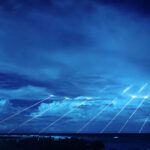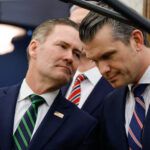The blinders on the US nuclear policy establishment
By Hugh Gusterson | January 8, 2019
 Blinders should probably be reserved for horses. (Photo credit: Emilio Labrador via Creative Commons.)
Blinders should probably be reserved for horses. (Photo credit: Emilio Labrador via Creative Commons.)
If there is such a thing as a nuclear deep state, it was on full display at a crowded event at Washington’s Brookings Institution on Monday. Over 160 people, 90 percent of them men, packed into a room built for about 140 to hear the nuclear cognoscenti opine on the topic of whether “the politics of New START and strategic modernization” is falling apart. The panelists were a who’s who of nuclear weapons policy: Madelyn Creedon (a former assistant secretary of defense and deputy administrator of the National Nuclear Security Administration); John Harvey (formerly principal deputy assistant secretary of defense); Rebecca Hersman (a former deputy assistant secretary of defense now lodged at the Center for Strategic and International Studies); Matthew Kroenig (a Georgetown University professor who has advised the US Defense Department and is at the Atlantic Council); and Brian McKeon (a former staffer on the Senate Committee on Foreign Relations who went on to hold high positions in the Obama White House and Defense Department).
You might think that the point of having five panelists, especially at something that calls itself a “think tank,” is that they would have diverse opinions about which they would debate. If so, you would have been disappointed. The five panelists agreed about almost everything they discussed—a dazzling display of Washington consensus thinking in action, despite the partisan polarization said to govern American politics today. They agreed that, when President Obama took office, the nuclear weapons complex was “underinvested” (McKeon), “underfunded, particularly on the manufacturing side” (Creedon), and “a nuclear wasteland” (Harvey). They agreed that the Obama Administration was right to increase the nuclear weapons budget to roughly $1 trillion over the next thirty years. (No one asked whether other urgent national needs, such as green energy, might be more important, or brought up inefficiencies in the weapons complex, such as the $3 billion cost overrun for the National Ignition Facility at the Lawrence Livermore National Laboratory). They agreed that New START, the 2010 treaty to further reduce US and Russian nuclear arsenals, provides valuable strategic stability, and that it would have been impossible to win ratification of the treaty in the US Senate absent the resolution pairing it with large amounts of money for “nuclear modernization.” They had a lively debate, though, over the semantics of whether this pairing of nuclear modernization and arms control should be characterized as the product of a “consensus” or a “coalition.”
New START (which limits the United States and Russia to 1,500 deployed warheads each) is set to expire in February 2021. If the treaty were renegotiated, it would have to be ratified again by the Senate—a tall order given the rightward lurch of the Republican Party since it was first ratified in 2010. However, the treaty can be extended as written for another five years by a simple agreement between Russian and American leaders. The panelists all agreed that this would be good, but that extension of the treaty is endangered by three things. The first is a US president and national security advisor who are, at best, indifferent to arms control. The second is a Russian leader who is poisoning the well of détente by breaching the terms of the Intermediate Nuclear Forces Treaty and pursuing a policy of expansionism in Ukraine. The third is the announced ambition of some Democrats—such as Washington State’s Adam Smith, the incoming chair of the House Armed Services Committee—to cut US nuclear weapons programs. Hersman likened such a cut to a risky move in the game Jenga, where you pull a supporting block out of a wobbly tower and hope the whole edifice does not collapse.
It is hard to disagree with the panelists’ view that the United States will be more secure and the world more stable if New START is extended. But listening to this star panel that had drawn a standing-room-only crowd to hear about the future of arms control, I was struck by its inside-the-Beltway myopia, by the power of Washington to enforce tunnel vision on smart people. The panelists seemed more concerned with preserving the consensus in Washington than looking afresh at the problem of nuclear weapons. I kept imagining their discussion as a word cloud. Some of the largest words would have been “Democrat,” “Republican,” “Obama,” “Trump,” “senate,” “appropriations,” “committee,” and “Department of Defense.” Certain words would have been missing from the word cloud altogether. For example, in this discussion on the future of arms control, no one mentioned, at all, that the following countries have nuclear weapons: Britain, France, Israel, India, Pakistan, and North Korea. None of these countries mattered as much as former Arizona Senator Jon Kyl, who was named repeatedly because of his role in brokering the deal that won enough support from Republicans to enable ratification of New START. (China entered the discussion largely in response to a question from a Brazilian diplomat who asked if it was time for a nuclear arms control treaty that included Beijing). The prospect of further nuclear proliferation—the possibility that more governments will obtain nuclear weapons than the current nine—was only mentioned obliquely, an astonishing failure of realist imagination. And no one talked about the fact that 69 countries have signed and 19 have ratified a treaty banning nuclear weapons altogether. As the panelists agreed among themselves that further reductions in nuclear stockpiles were unlikely for now, given the state of relations with Russia and Washington politics, no one thought it worth mentioning that over a third of all countries believe the weapons should be abolished altogether, and no one asked how these abolitionist nations (and others) might react to the collapse of the New START regime. Nor did anyone ask whether there might be a new urgency in addressing the problem of nuclear weapons in light of what we have learned from our experiment over the last two years of handing the nuclear launch codes—and thus the power to end all life on earth—to an egomaniacal, impulsive, immature, simple-minded narcissist who likes to threaten people. Twenty-five years after the end of the Cold War, while many countries are disturbed that the two largest nuclear powers are revitalizing their nuclear stockpiles, America’s nuclear elite framed the issue largely as a problem of factional politics inside the Beltway.
As anyone who has studied the history of the Roman Empire, Spain, or Great Britain knows, as empires decline, they become more provincial. This is what imperial decline looks like: a global power, whose military bestrides the world, gazing at its own navel.
Together, we make the world safer.
The Bulletin elevates expert voices above the noise. But as an independent nonprofit organization, our operations depend on the support of readers like you. Help us continue to deliver quality journalism that holds leaders accountable. Your support of our work at any level is important. In return, we promise our coverage will be understandable, influential, vigilant, solution-oriented, and fair-minded. Together we can make a difference.
Topics: Columnists, Nuclear Risk, Nuclear Weapons
















I think much of the “crazy” coming out of Washington these days is a manifestation of insecurity and frustration over its diminishing influence in the world. Russia and China are becoming increasingly assertive and there is little to nothing the US can do about it.
It’s not that “the US can do nothing about it,” but rather that Washington has become lazy and stupid, relying on military force in the first resort, rather than better tools with which to influence others with whom we share the world.